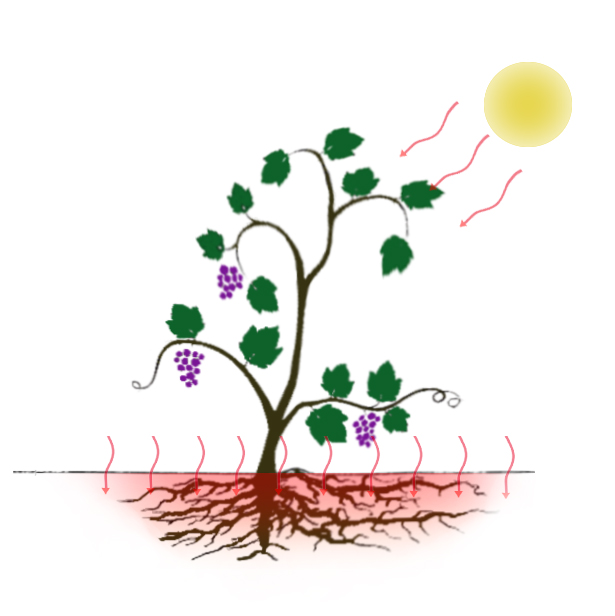

气温和根区温度对葡萄叶片光合荧光特性的影响
收稿日期: 2021-07-25
录用日期: 2021-12-28
网络出版日期: 2021-12-28
基金资助
国家重点研发计划(2019YFD1000101);财政部和农业农村部和国家现代农业产业技术体系(CARS-29-zp-1)
Effects of High Air and Root Zone Temperature on Photosynthetic Fluorescence Characteristics of Grape Leaves
Received date: 2021-07-25
Accepted date: 2021-12-28
Online published: 2021-12-28

王浩 , 王明 , 梁婷 , 姚玉新 , 杜远鹏 , 高振 . 气温和根区温度对葡萄叶片光合荧光特性的影响[J]. 植物学报, 2022 , 57(2) : 209 -216 . DOI: 10.11983/CBB21122

| [1] | 陈景玲, 王静, 王谦, 吴明作, 袁远, 赵勇 (2014). 基于叶绿素荧光的荆条灌丛对栓皮栎幼苗庇荫效应研究. 西北林学院学报 29(4), 46-53. |
| [2] | 高玉录, 仝亚军, 杨兴旺, 翟衡, 杜远鹏, 孙永江 (2020). 乙酸及ABA对田间高温胁迫下 ‘摩尔多瓦’ 葡萄叶片光抑制的影响. 中外葡萄与葡萄酒 (5), 1-5. |
| [3] | 郭倩倩, 周文彬 (2019). 植物响应联合胁迫机制的研究进展. 植物学报 54, 662-672. |
| [4] | 侯丽媛, 董艳辉, 李亚莉, 王育川, 赵佳, 刘江, 秦永军, 吴慎杰 (2021). 藜麦抗旱性研究进展与展望. 江苏农业科学 49(11), 22-28. |
| [5] | 李鹏民, 高辉远, Strasser RJ (2005). 快速叶绿素荧光诱导动力学分析在光合作用研究中的应用. 植物生理与分子生物学学报 31, 559-566. |
| [6] | 罗海波, 马苓, 段伟, 李绍华, 王利军 (2010). 高温胁迫对 ‘赤霞珠’ 葡萄光合作用的影响. 中国农业科学 43, 2744-2750. |
| [7] | 孙永江, 付艳东, 杜远鹏, 翟衡 (2013). 不同温度/光照组合对 ‘赤霞珠’ 葡萄叶片光系统II功能的影响. 中国农业科学 46, 1191-1200. |
| [8] | 夏镇卿, 司雷勇, 金岩, 扶亚芳, 王奇, 路海东 (2020). 根区增温对玉米幼苗主要代谢物傅里叶红外光谱特性及叶绿素含量的影响. 光谱学与光谱分析 40, 1283-1288. |
| [9] | 向芬, 周强, 田向荣, 陈功锡, 肖艳 (2014). 不同生境吉首蒲儿根叶片形态和叶绿素荧光特征的比较. 生态学报 34, 337-344. |
| [10] | 许大全, 张玉忠, 张荣铣 (1992). 植物光合作用的光抑制. 植物生理学通讯 28, 237-243. |
| [11] | 赵秀婷, 王延双, 段劼, 马履一, 何宝华, 贾忠奎, 桑子阳, 朱仲龙 (2021). 盐胁迫对红花玉兰嫁接苗生长和光合特性的影响. 林业科学 57, 43-53. |
| [12] | Al-Khatib K, Paulsen GM (1984). Mode of high temperature injury to wheat during grain development. Physiol Plant 61, 363-368. |
| [13] | Baker NR (2008). Chlorophyll fluorescence: a probe of photosynthesis in vivo. Annu Rev Plant Biol 59, 89-113. |
| [14] | Ding XT, Jiang YP, He LZ, Zhou Q, Yu JZ, Hui DF, Huang DF (2016). Exogenous glutathione improves high root- zone temperature tolerance by modulating photosynthesis, antioxidant and osmolytes systems in cucumber seedlings. Sci Rep 6, 35424. |
| [15] | Foster WJ, Ingram DL, Nell TA (1991). Photosynthesis and root respiration in Ilex crenata ‘rotundifolia’ at supraoptimal root-zone temperatures. HortScience 26, 535-537. |
| [16] | Gur A, Hepner J, Shulman Y (1979). The influence of root temperature on apple trees. IV. The effect on the mineral nutrition of the tree. J Hortic Sci 54, 313-321. |
| [17] | Hao HP, Jiang CD, Zhang SR, Tang YD, Shi L (2012). Enhanced thermal-tolerance of photosystem II by elevating root zone temperature in Prunus mira Koehne seedlings. Plant Soil 353, 367-378. |
| [18] | Jiang CD, Jiang GM, Wang XZ, Li LH, Biswas DK, Li YG (2006). Increased photosynthetic activities and thermostability of photosystem II with leaf development of elm seedlings (Ulmus pumila) probed by the fast fluorescence rise OJIP. Environ Exp Bot 58, 261-268. |
| [19] | Kramer DM, Johnson G, Kiirats O, Edwards GE (2004). New fluorescence parameters for the determination of QAredox state and excitation energy fluxes. Photosynth Res 79, 209-218. |
| [20] | Kyle DJ (1987). The biochemical basis for photoinhibition of photosystem II. In: Kyle DJ, Osmond CB, Arntzen CJ, eds. Photoinhibition. Amsterdam: Elsevier. pp. 197-226. |
| [21] | Liu XZ, Huang BR (2000). Heat stress injury in relation to membrane lipid peroxidation in creeping bentgrass. Crop Sci 40, 503-510. |
| [22] | Mehta P, Allakhverdiev SI, Jajoo A (2010). Characterization of photosystem II heterogeneity in response to high salt stress in wheat leaves (Triticum aestivum). Photosynth Res 105, 249-255. |
| [23] | Strasser BJ (1997). Donor side capacity of photosystem II probed by chlorophyll a fluorescence transients. Photosynth Res 52, 147-155. |
| [24] | Takahashi S, Badger MR (2011). Photoprotection in plants: a new light on photosystem II damage. Trends Plant Sci 16, 53-60. |
| [25] | van der Westhuizen MM, Oosterhuis DM, Berner JM, Boogaers N (2020). Chlorophyll a fluorescence as an indicator of heat stress in cotton (Gossypium hirsutum L.). S Afr J Plant Soil 37, 116-119. |
| [26] | Wu HY, Liu LA, Shi L, Zhang WF, Jiang CD (2021). Photosynthetic acclimation during low-light-induced leaf senescence in post-anthesis maize plants. Photosynth Res 150, 313-326. |
| [27] | Xia ZQ, Si LY, Jin Y, Fu YF, Wang Q, Lu HD (2021). Effects of root zone temperature increase on physiological indexes and photosynthesis of different genotype maize seedlings. Russ J Plant Physiol 68, 169-178. |
| [28] | Xu QZ, Huang BR (2000). Growth and physiological responses of creeping bentgrass to changes in air and soil temperatures. Crop Sci 40, 1363-1368. |
| [29] | Xu QZ, Huang BR, Wang ZL (2002). Photosynthetic responses of creeping bentgrass to reduced root-zone temperatures at supraoptimal air temperature. J Am Soc Hort Sci 127, 754-758. |
| [30] | Yamori W, Hikosaka K, Way DA (2014). Temperature response of photosynthesis in C3, C4, and CAM plants: temperature acclimation and temperature adaptation. Photosynth Res 119, 101-117. |
/
| 〈 |
|
〉 |